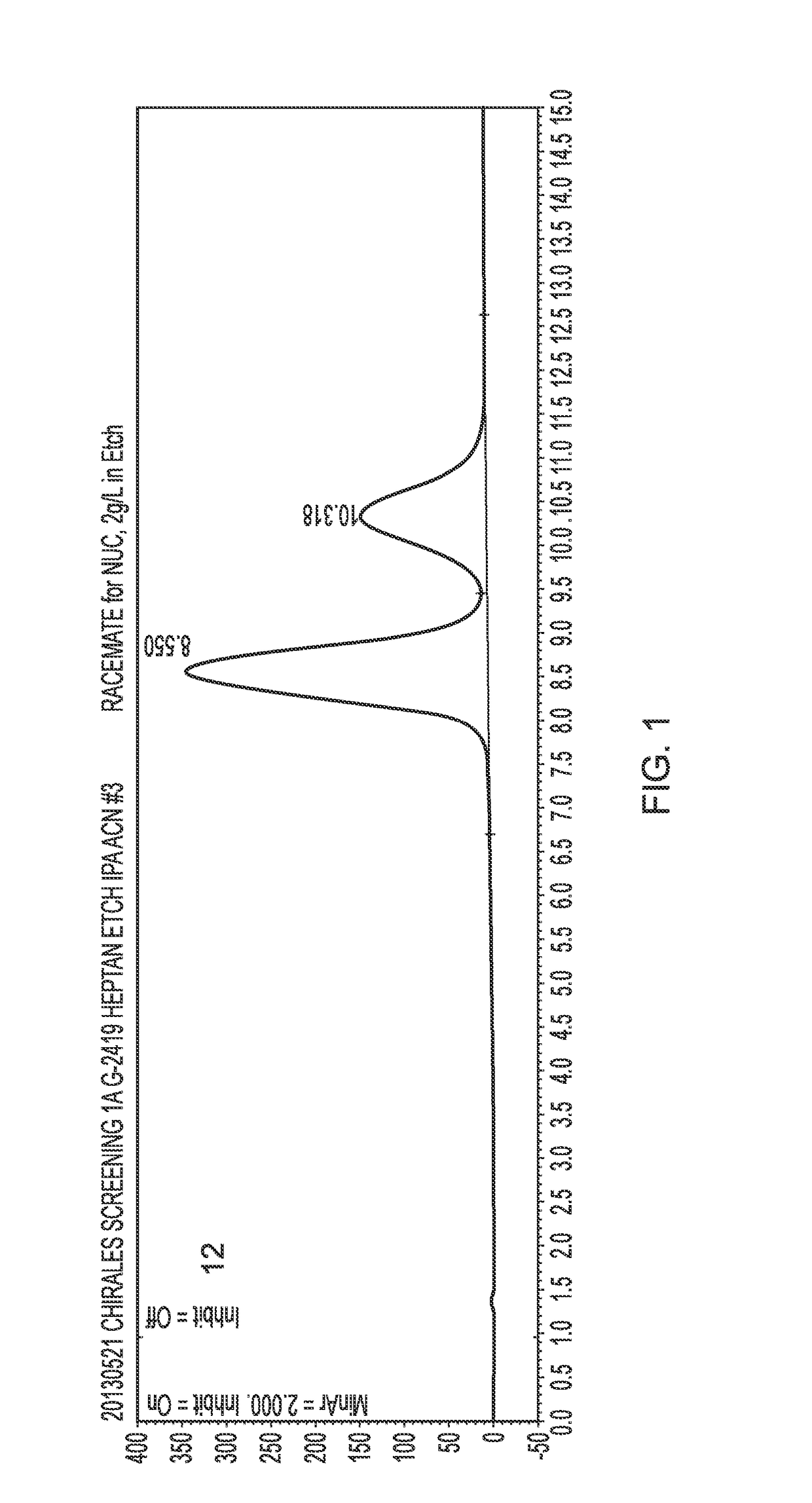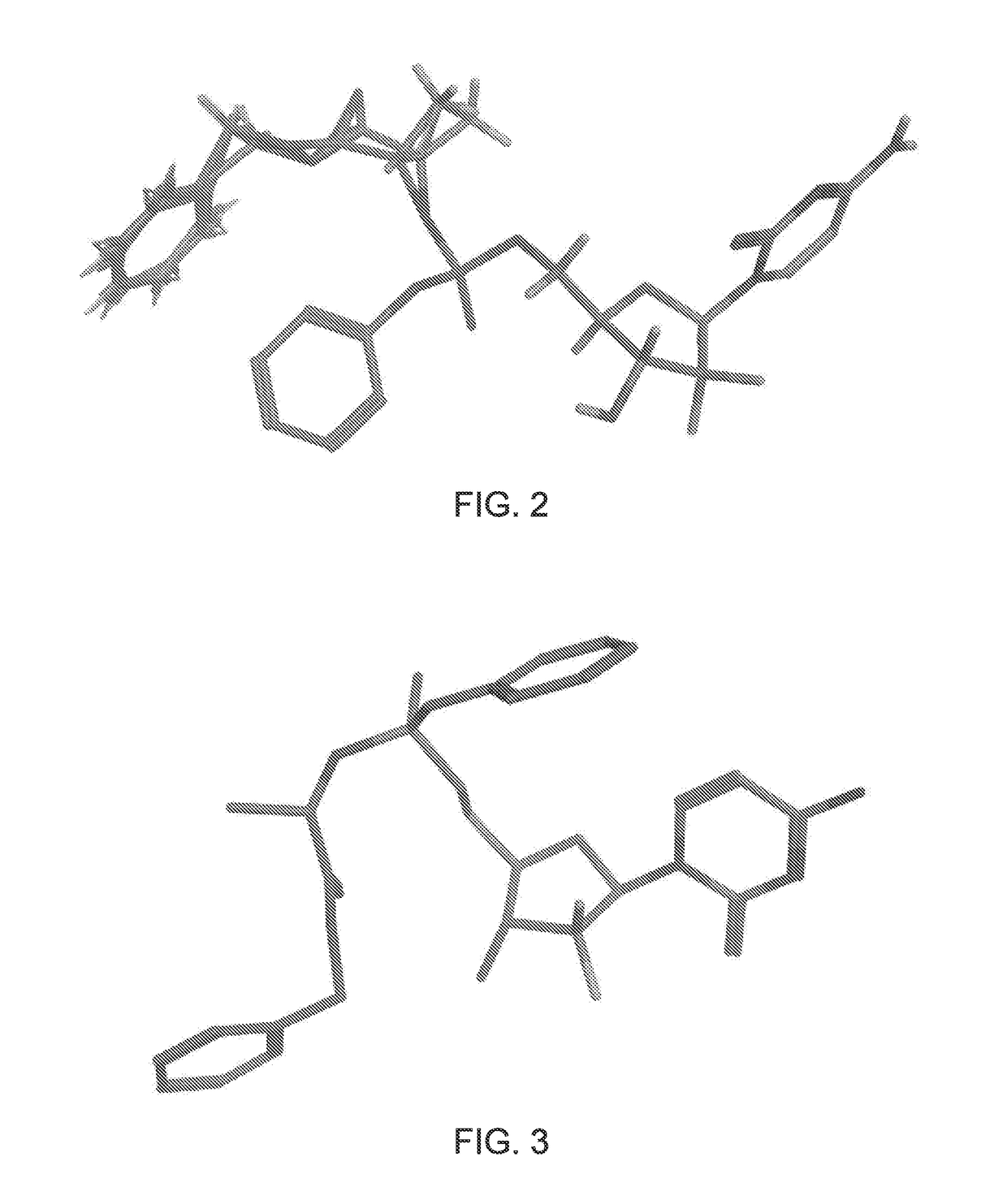Gemcitabine prodrugs
a technology of gemcitabine and prodrugs, applied in the field of gemcitabine prodrugs, can solve the problems of limited clinical utility of gemcitabine, poor water soluble ability, and high lipophilicity, and achieve the effects of less intrinsic clearance, increased exposure to r-epimer, and different pharmacokinetic and pharmacodynamic profiles
- Summary
- Abstract
- Description
- Claims
- Application Information
AI Technical Summary
Benefits of technology
Problems solved by technology
Method used
Image
Examples
example 1
[0092]The (R) and (S) isomers were separated by HPLC under the following conditions:[0093]Equipment: Agilent 1200™ series with DAD detector[0094]Flow rate: 1.0 mL / min[0095]Column: Chiralpak AD™; 250×4.6 mm ID (normal phase)[0096]Temperature: ambient[0097]Particle size: 20 μm[0098]Feed: dissolved in MeOH; 10g / L[0099]Solvent: n-heptane / IPA 10->50% IPA[0100]The chromatogram is shown in FIG. 1. The (S)-epimer eluted at 8.6 min and the (R)-epimer eluted at 10.3 minutes.
[0101]Characterisation Methods and Materials: Proton (1H), carbon (13C), phosphorus (31P) and fluorine (19F) NMR spectra were recorded on a Bruker Avance 500 spectrometer at 25° C. Spectra were auto-calibrated to the deuterated solvent peak and all 13C NMR and 31P NMR were proton-decoupled. The purity of final compounds was verified to be >95% by HPLC analysis using Varian Polaris C18-A (10 μM) as an analytic column with a gradient elution of H2O / MeOH from 100 / 0 to 0 / 100 in 35 min. The HPLC analysis was conducted by Varian...
example 2
[0115]The solubilities of NUC-1031 and its diastereoisomers were determined in a range of pharmaceutically acceptable solvent systems. The protocol adopted was as follows:
[0116]A small volume, 1-2 mL, of each solvent system was prepared and a weight of the compound in question was added. The solutions were stirred for approximately 4 hours and then 0.45 μL membrane filtered. The concentration of the compound in question in the filtrate was then determined by HPLC assay.
[0117]Based on the gemcitabine dosage schedule used in the treatment of pancreatic cancer, the molecular weight adjusted dose of NUC-1031 would be about 3200 mg, given as an infusion once weekly. As an indication of the level of solubility required, taking a notional target of a 500 mL infusion volume, the required solubility of the NUC-1031 would be >6 mg / ml in the infusion fluid. However, this solubility level is just an indication and solubilities below can still provide effective therapies.
[0118]Table 5 shows the ...
example 3
[0121]To evaluate the differential uptake of the (R)- and (S)-epimers into cyclodextrin, 31P NMR spectra of NUC-1031 isomers mixture after treatment with HP-β-CD in D2O was recorded.
[0122]NMR studies. 1H NMR (500 MHz) and 31P NMR (202 MHz) were recorded on a Bruker Avance 500 MHz spectrometer at 25° C. Chemical shifts (δ) are quoted in parts per million (ppm) relative to internal D2O (δ 4.9 1H NMR) or external 85% H3PO4 (δ 0.00 31P NMR). Both HPLC and NMR studies were carried out at room temperature
[0123]HPLC studies. Analytical High Performance Liquid Chromatography (HPLC) analysis was performed using a ThermoScientific system. Reverse-phase HPLC analyses were carried out on a SCIENTIFIC Hypersil Gold C18, 5 μ, 150×4.6 mm eluting with H2O / CH3CN from 90 / 10 to 0 / 100 in 30 min at a flow rate of 1mL / min and at the detection wavelength of 280 nm. The retention times of NUC-1031 epimers (dissolved in MeOH) are observed respectively at 13.58 min for the (S)-epimer 3 and at 13.44 min for t...
PUM
| Property | Measurement | Unit |
|---|---|---|
| Fraction | aaaaa | aaaaa |
| Polarity | aaaaa | aaaaa |
Abstract
Description
Claims
Application Information
 Login to View More
Login to View More - R&D
- Intellectual Property
- Life Sciences
- Materials
- Tech Scout
- Unparalleled Data Quality
- Higher Quality Content
- 60% Fewer Hallucinations
Browse by: Latest US Patents, China's latest patents, Technical Efficacy Thesaurus, Application Domain, Technology Topic, Popular Technical Reports.
© 2025 PatSnap. All rights reserved.Legal|Privacy policy|Modern Slavery Act Transparency Statement|Sitemap|About US| Contact US: help@patsnap.com



